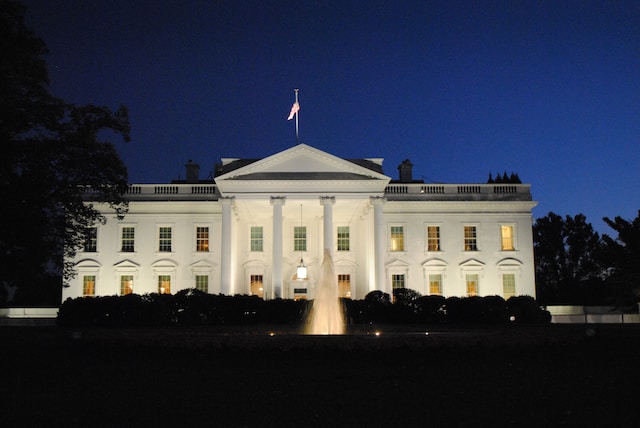The legislative branch of government is responsible for making laws, while the executive branch is responsible for enforcing and administering those laws. In other words, the legislative branch creates policies and the executive branch implements them.
The Legislative Branch
(Photo by Kyle Glenn on Unsplash )

The Legislative Branch is one of the three branches of the government in a typical democratic system of government, alongside the Executive Branch and the Judicial Branch. The Legislative Branch is responsible for creating laws that govern the country, passing budgets and deciding how money should be spent, and providing oversight of the executive branch to ensure that it is operating within the law and the constitution.
In many countries, the Legislative Branch is composed of two houses or chambers, such as the House of Representatives and the Senate in the United States Congress. The role of each chamber can vary depending on the country and the system of government in place. In some systems, one chamber may have more power than the other, while in others, both chambers have equal power.
The members of the Legislative Branch are typically elected by the citizens of the country or appointed by other government officials. They are responsible for representing the interests of their constituents and ensuring that the laws they pass are in the best interests of the country as a whole.
The Executive Branch
(Photo by Tabrez Syed on Unsplash )

The Executive Branch is one of the three branches of the government in the United States. It is responsible for enforcing the laws and includes the President of the United States, the Vice President, and the Cabinet.
The President is the head of the Executive Branch and is elected every four years. The President is responsible for executing and enforcing the laws passed by Congress, as well as serving as the commander-in-chief of the military. The President also has the power to veto bills passed by Congress, although Congress can override a veto with a two-thirds majority vote.
The Vice President supports the President and is first in line of presidential succession if the President is unable to fulfill his or her duties. The Cabinet is composed of the heads of the executive departments, such as the Secretary of State, the Secretary of Defense, and the Attorney General, among others. The Cabinet advises the President on matters related to their departments and helps to implement the President’s policies and programs.
The Executive Branch also has the power to issue executive orders, which are directives issued by the President that have the force of law, although they can be challenged in court. The President can also issue pardons and reprieves for federal crimes and make treaties with foreign governments, although the Senate must ratify any treaty by a two-thirds majority vote.
Overall, the Executive Branch plays a crucial role in the functioning of the government by enforcing the laws and implementing policies that affect the nation.
Checks and Balances
The U.S. Constitution provides for a system of checks and balances, whereby no one branch of government has too much power. This is accomplished through the distribution of powers between the legislative, executive, and judicial branches.
The legislature makes the laws, which the executive then carries out. The judiciary interprets the laws and can declare them unconstitutional if they violate the Constitution. This system ensures that no one branch becomes too powerful and that all three branches are accountable to the people.
Who is the leader of the executive branch?
The leader of the executive branch is the President of the United States. The President is responsible for carrying out the laws of the country and for representing the United States to other countries. The President is also responsible for appointing Cabinet members and Supreme Court justices.
What legislative body has two branches?
The most common legislative body with two branches is the bicameral legislature. This type of legislature has two chambers, which may be based on a geographic division, such as in the United States Congress, or may be based on a different division, such as in the Indian Parliament. The two chambers of a bicameral legislature often have different powers and functions, with one chamber being primarily responsible for passing laws and the other chamber being responsible for overseeing the executive branch.
Legislative Process Overview
The legislative process is the process by which a bill or other piece of legislation is introduced, debated, and voted on in Congress. The executive branch of the federal government is responsible for carrying out the laws that are enacted by Congress, and the president has the power to veto legislation that he or she does not agree with.
How a Bill Becomes a Law
In the United States, the process of making laws is divided between the legislative and executive branches. The legislature, made up of Congress, is responsible for proposing new laws. The executive, made up of the president and his administration, is responsible for carrying out laws.
The process of making a law begins with an idea. Someone, either a member of Congress or a citizen, comes up with an idea for a new law. If the person is a member of Congress, they will draft a bill and introduce it to their fellow members. If the person is a citizen, they will need to find a sponsor for their bill.
Once introduced, the bill will be debated in committee before it is voted on by the full House or Senate. If the bill passes both chambers, it will then go to the president to be signed into law. If the president vetoes the bill, it can still become law if two-thirds of both chambers vote to override his veto.
Who is in the executive branch?
The executive branch of the United States federal government is responsible for carrying out the laws of the nation. The president is the head of the executive branch, and he or she is responsible for making sure that the laws are enforced. The president is also responsible for appointing Cabinet secretaries and Supreme Court justices.
What is the role of the judiciary?
The judiciary is the branch of government responsible for interpreting and applying the law. Judges hear cases and make decisions based on the law and their own interpretation of it. They also oversee the legal system, ensure that it is fair and impartial, and protect the rights of citizens.
Featured Image By – Darren Halstead on Unsplash








